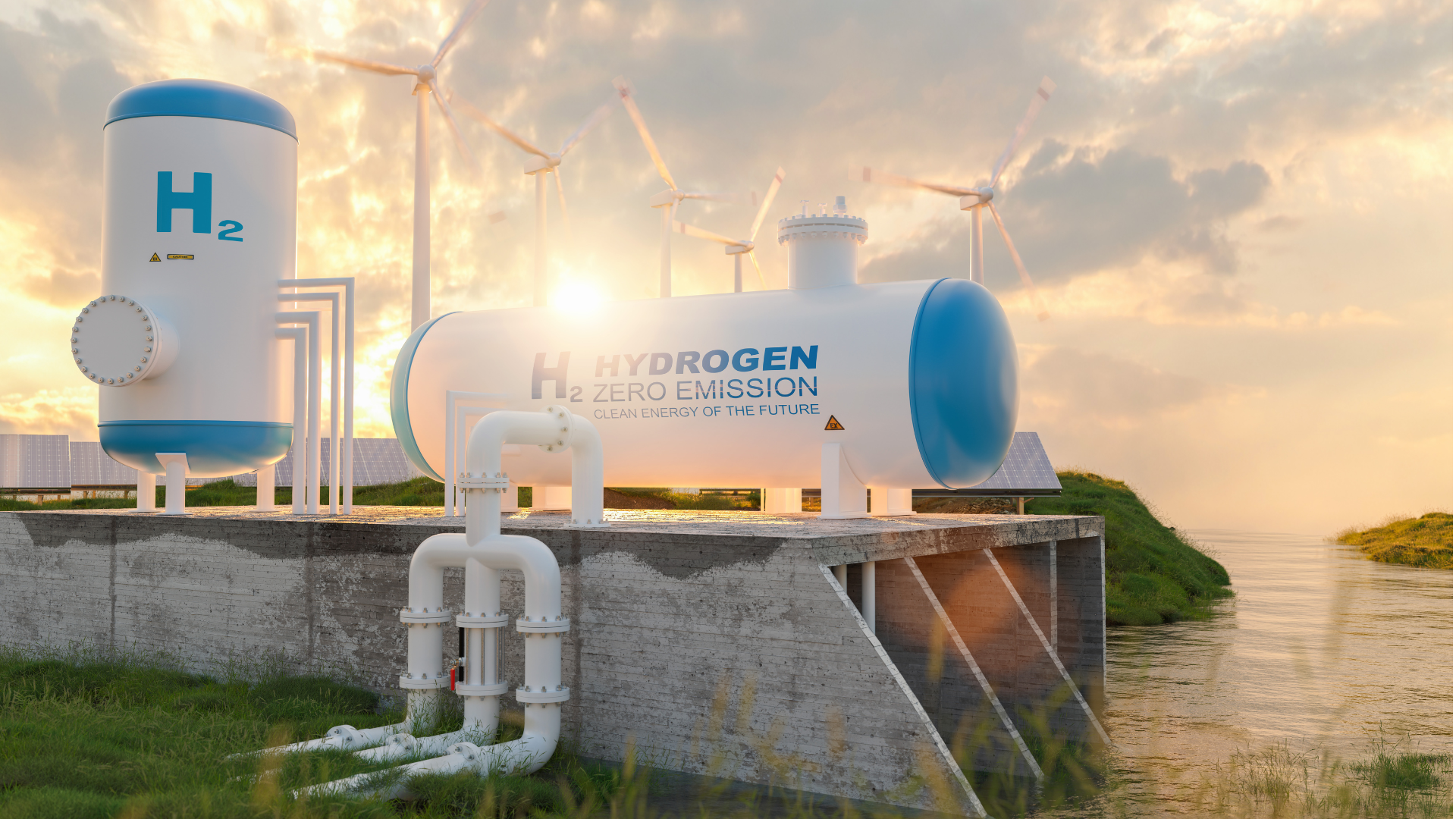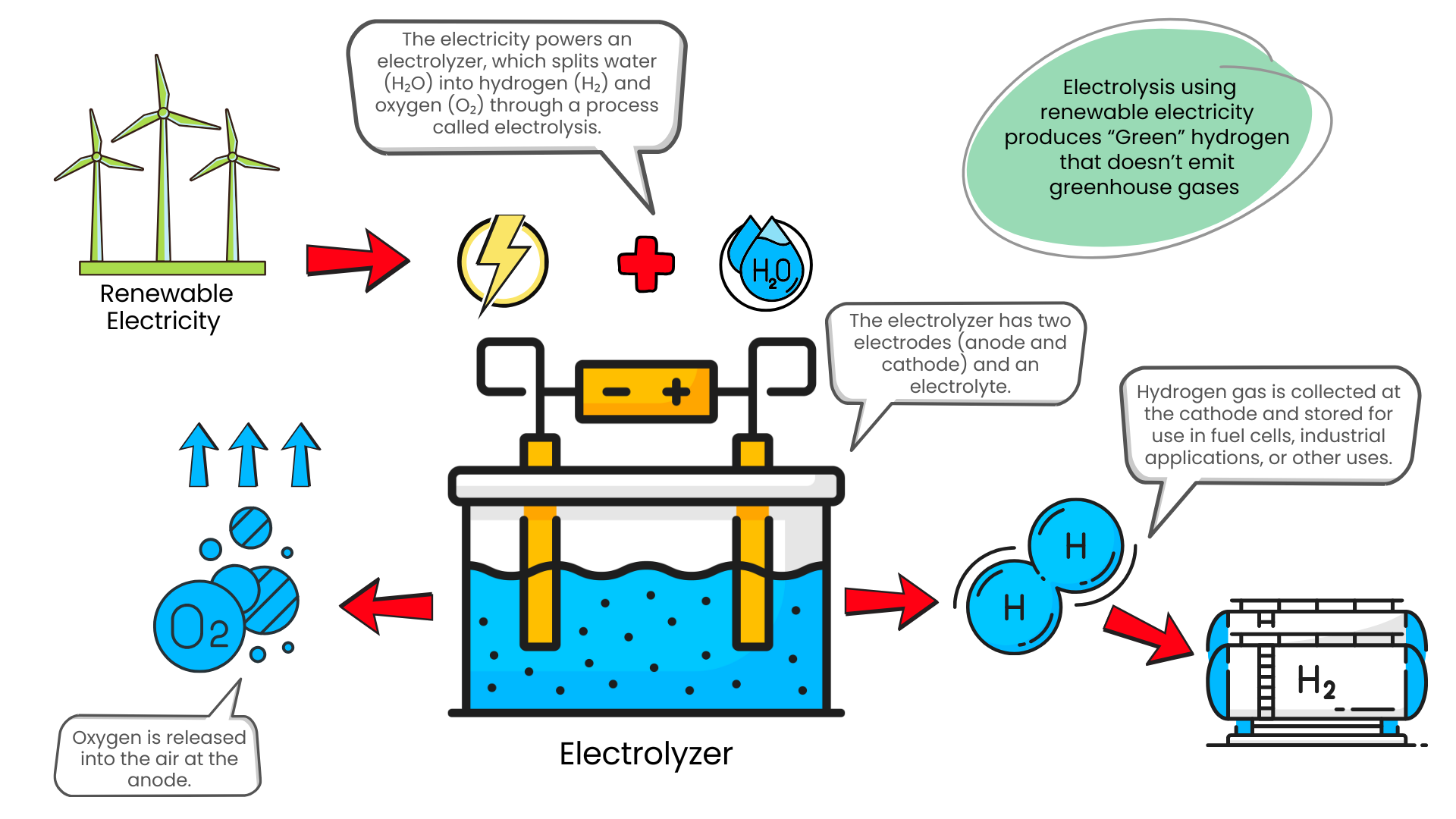What is Hydrogen?
Hydrogen (H₂) is the lightest and most abundant element in the universe. It is a colourless, odourless gas.
Like electricity, hydrogen is an energy carrier that emits no CO2 when it is used. While electricity carries energy as electrons, hydrogen carries energy as molecules.
Low-carbon hydrogen is a promising solution for reducing emissions, especially in energy sectors that are challenging to decarbonize, including heavy transportation, shipping and other marine vessels, and high-temperature industrial processes.
Its high energy density, ability to be produced from various sources, long-term storage capabilities, and versatile end-uses make it a valuable alternative to traditional fuels.

Green Hydrogen
Green hydrogen is produced using the process of electrolysis using renewable electricity to split water molecules into hydrogen and oxygen.

Facts About Hydrogen
- Hydrogen can play an important role in grid-scale energy storage to enable increased energy independence in Atlantic Canada.
- An important fuel for the transportation sector, an area that has made significant emissions reductions.
- Local municipalities and local industries are looking to hydrogen to help decarbonize end uses including heavy transportation, like trucks, buses, and trains, manufacturing processes and electricity generation - all of the things that are difficult to decarbonize.
- Hydrogen can be stored in large volumes and easily transported. We can build out additional renewable wind and solar, produce clean hydrogen and store it until we need it in the cold winter months. This is a great complement to lithium-ion batteries that effectively store energy for a brief period of time.
- Hydrogen can also be blended into the natural gas distribution system to deliver cleaner energy to buildings for space and water heat. This will be especially helpful on the coldest winter days to help when heat pumps are not operating efficiently.
- We've got an abundance of onshore and offshore wind resources that can produce the renewable electricity that we'll we need to make green hydrogen. We can leverage excess, and often wasted, renewable electricity and even build out surplus to produce hydrogen.
- The natural gas distribution system in Nova Scotia and New Brunswick is very modern and made from polyethylene plastic pipes that are needed to distribute hydrogen. Because of this, we've got the most hydrogen-ready gas grids in North America.
Frequently asked questions
Hydrogen (H2) is a gas, and like electricity, it's an energy carrier. Hydrogen doesn't emit any greenhouse gas emissions when it is used. However, hydrogen is also like electricity in that for it to be zero-emitting, it must be produced using clean energy.
Yes, hydrogen is very safe. It's light and quickly disperses in air. There are, however, risks to any energy delivery mechanism. The safety risks inherent to hydrogen are like those of natural gas. The gas industry has a strong safety record and is well positioned to address these risks.
- Green Hydrogen is low-carbon hydrogen produced from renewable electricity. An electrolyzer uses renewable electricity to split water molecules to create clean-burning, 100% renewable hydrogen and oxygen.
- Blue Hydrogen is low-carbon, but non-renewable hydrogen that's produced from fossil fuels, typically natural gas, and uses carbon capture and storage to sequester the CO2 that's emitted during the hydrogen production process, resulting in an energy source that's about 90% cleaner than natural gas.
- Grey Hydrogen is produced from fossil fuels, typically natural gas, through thermal processes that break down larger molecules like methane into hydrogen and carbon. This is a common method of global hydrogen production and it results in CO2 emissions at a similar level to that of natural gas.
Most natural gas appliances and heating equipment can use a blend of up to 20% hydrogen. With concentrations higher than 20% of hydrogen in the gas grid, we'll need to start replacing appliance parts.
The development of a hydrogen economy is an exciting opportunity for the region, but it does come with its challenges. We are establishing a coordinated effort from energy partners across the region to ensure we solve the challenges together.
- The region and each province will need a strong regulatory framework with incentives to transform and decarbonize the region's energy systems.
- Lack of collaboration. Our energy policies are provincial and focus on specific fuel types - electricity, natural gas, refined petroleum products. We need to be looking at the entire energy system in a completely new and regionally coordinated way, not in provincial, utility, or individual end use silos.
- Lack of knowledge and understanding about hydrogen by the general public, government, and even stakeholders within the energy industry. Many are just starting now to think about hydrogen and energy systems integration and the role it might play in the Maritimes.
- Sole focus on electrification solutions. We agree that electrification will be very important to achieve the kind of energy system transformation that we'll need to get to net-zero. However, the reality is that electrification alone simply won't be enough. Studies from around the world have concluded that energy efficiency, combined with the decarbonization of electricity generation will be very important, yet insufficient to achieve net-zero emissions.
- Energy costs. Clean hydrogen is more expensive than natural gas; however, like other green energy technologies the price of green hydrogen is expected to significantly decrease in the over the course of the next decade.
Yes, up to about 20% without changing equipment and appliances. As the balance of delivered gas shifts closer to 100% hydrogen, equipment changes for end users will become necessary. Hydrogen-ready equipment is under development now and is becoming commercially available. Our modern gas distribution systems are mostly plastic, which can deliver 100% hydrogen. Some steel pipes may need to be replaced as hydrogen concentrations increase.
